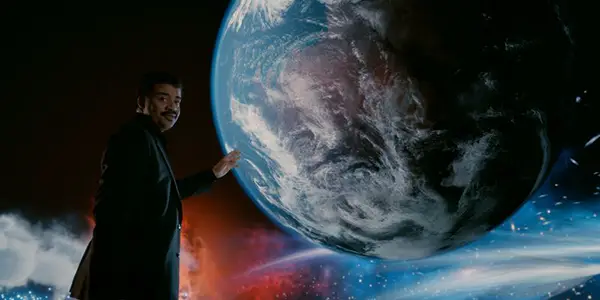COSMOS: POSSIBLE WORLDS (S3E6) “The Man Of A Trillion Worlds”: A Beautiful Tribute To Carl Sagan

Digital Media Program Coordinator and Professor at Southern Utah University…
“As long as there have been humans, we have searched for our place in the Cosmos.” – Carl Sagan
The known universe is incomprehensibly vast. At times, it can be difficult to reconcile our need to belong, to feel important, considering how tiny we truly are. As Sagan himself said: “There is perhaps no better demonstration of the folly of human conceits than this distant image of our tiny world.” And yet, as he also said, our “pale blue dot” is home to everything humanity has ever known, good or evil. “In our obscurity, in all this vastness, there is no hint that help will come from elsewhere to save us from ourselves.” In the end, our survival up to us.
Episode Summary
Our species coming to understand the vastness of the universe is a story as old as humanity. Philosophers and scientists have mused on what little we know, staring up into the blackness of night to chart the stars, usually looking for evidence of a designing hand. Gerard Kuiper and Harold Urey, two feuding twentieth-century contemporaries from different scientific fields, were together responsible for helping us to move past the human-centric view of the universe, and ultimately, for Carl Sagan. Both men mentored the budding scientist, who ultimately gave us Cosmos, and so much more.

Comprehending Eternal Infinity
Step by step, humanity’s thinking regarding the larger universe has slowly evolved, from quaint stories of mythological beings through to modern understanding (which will no doubt one day be considered quaint as well). Great strides in our collective thought have often come at significant cost, paid by some combination of societal anguish, or the personal sacrifices of history’s greatest heroes.
Throughout the great story of humanity’s scientific advancement, a tragic constant has been segregation; the separation of different scientific fields, as well as of scientific understanding from the masses. While there have been some precious few champions for interdisciplinary science throughout history, these exceedingly rare lights have been tragically overshadowed by the vast darkness of narcissistic hubris.

Then came Carl Sagan. While the realization of his vision was assisted by advancements in communications technology, he still managed, in his tragically brief lifetime, to not only bring about the greatest era of interdisciplinary scientific study, but also to provide unprecedented access to science for the masses. The Man of a Trillion Worlds is an episode that stands as Possible Worlds’ tribute to this giant among men.
As host Neil deGrasse Tyson explains during a virtual tour of possible earth-like worlds throughout the cosmos, thanks to the interdisciplinary sciences advanced by Sagan and others, we now have a general understanding of how vast our universe may be. Considering what we know about the origins of galaxies, suns, and planets, coupled with the incomprehensibly massive size of the universe, we can now speculate that every second, a thousand new solar systems are born. How remarkably small and insignificant we are.
And yet, as Sagan was fond of saying, there is always more. More to see, more to experience, more to understand, and ultimately, more to become. Considering the tribute that is this episode, I can think of no better way to write this review than to offer a tribute of my own, insignificant though it may be. And I can think of no better tribute than to appeal to my human family, as he so often did, to find a way to better itself, and ultimately, to comprehend eternal infinity.

Look again at that dot. That’s here. That’s home. That’s us. On it everyone you love, everyone you know, everyone you ever heard of, every human being who ever was, lived out their lives. The aggregate of our joy and suffering, thousands of confident religions, ideologies, and economic doctrines, every hunter and forager, every hero and coward, every creator and destroyer of civilization, every king and peasant, every young couple in love, every mother and father, hopeful child, inventor and explorer, every teacher of morals, every corrupt politician, every “superstar,” every “supreme leader,” every saint and sinner in the history of our species lived there-on a mote of dust suspended in a sunbeam.
The Earth is a very small stage in a vast cosmic arena. Think of the endless cruelties visited by the inhabitants of one corner of this pixel on the scarcely distinguishable inhabitants of some other corner, how frequent their misunderstandings, how eager they are to kill one another, how fervent their hatreds. Think of the rivers of blood spilled by all those generals and emperors so that, in glory and triumph, they could become the momentary masters of a fraction of a dot.
Our posturings, our imagined self-importance, the delusion that we have some privileged position in the Universe, are challenged by this point of pale light. Our planet is a lonely speck in the great enveloping cosmic dark. In our obscurity, in all this vastness, there is no hint that help will come from elsewhere to save us from ourselves.
The Earth is the only world known so far to harbor life. There is nowhere else, at least in the near future, to which our species could migrate. Visit, yes. Settle, not yet. Like it or not, for the moment the Earth is where we make our stand.
It has been said that astronomy is a humbling and character-building experience. There is perhaps no better demonstration of the folly of human conceits than this distant image of our tiny world. To me, it underscores our responsibility to deal more kindly with one another, and to preserve and cherish the pale blue dot, the only home we’ve ever known.
-Carl Sagan
Cosmos: Possible Worlds Season 3 Episode 6: The Man of a Trillion Worlds, aired on March 23, 2020 on National Geographic.
Does content like this matter to you?
Become a Member and support film journalism. Unlock access to all of Film Inquiry`s great articles. Join a community of like-minded readers who are passionate about cinema - get access to our private members Network, give back to independent filmmakers, and more.
Digital Media Program Coordinator and Professor at Southern Utah University and Southwest Technical College; M.Ed.; Author at Labyrinth Learning and Film Inquiry. Passionate educator of film theory and history. World-class nerd with a wide array of interests and a deep love for many different fandoms.













